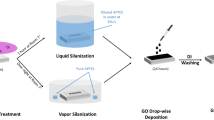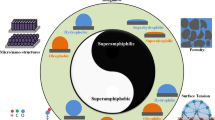Abstract
In this work, we directly observed the evolution of air/water interfaces suspended between polydimethylsiloxane (PDMS) microlines when water droplets reduced their sizes due to evaporation. The inclined angles of the microline sidewalls were slightly larger than 90°. Two important phenomena were observed regarding the transition from Cassie–Baxter to Wenzel States. First, when a water droplet gradually shrank, an air/water interface between two neighboring microlines increased its deflection but decreased its angle with the vertical direction. In the meanwhile, the two edges of this interface were still at the top corners of the two microlines. Second, once water passed the top corners of these two microlines, it kept moving down and filled the gap. Based on these two phenomena, the equilibrium of a triple line and the uniformity of pressure inside a small water droplet, critical values of droplet sizes and Laplace pressure were derived to predict when the transition would occur on microlines. The derived theoretical relationships indicate that air/water interfaces may be stationary on both top corners and sidewalls of microlines if the inclined angles of the microline sidewalls are less than 90°. Otherwise, the interfaces can only be stationary at the top corners of the microlines. The predicted values of droplet sizes for the case that the inclined angles of these sidewalls are larger than 90° were validated by experimental results on three arrays of PDMS microlines. In addition, we also directly observed the evolution of air/water interfaces on PDMS microlines when a water droplet was slowly pressed using a glass slide. The critical values of the droplet sizes derived in the case of evaporation applied to this pressing case as well, and had a good match with experimental results on the three arrays of PDMS microlines. In addition to the cases of evaporation and pressing, the theoretical relationships derived in this work may also apply to other cases, in which Laplace pressure is gradually increased inside a liquid droplet and half sizes of the droplet are less than the capillary length of the liquid. Finally, based on developed transition criteria, a set of criteria were also proposed to design microlines for reducing the critical droplet size that triggers the transitions from Cassie–Baxter to Wenzel States.









Similar content being viewed by others
References
Adamson AV (1990) Physical chemistry of surfaces. Wiley, New York
Cassie ABD, Baxter S (1944) Wettability of porous surfaces. Trans Faraday Soc 40:546–551
Cheng Y-T, Rodak DE, Angelopoulos A, Gacek T (2005) Microscopic observations of condensation of water on lotus leaves. Appl Phys Lett 87:194112–194114
Gibbs JW (1961) Scientific papers, vol 1. Longmans, London, p 326 (Dover Reprint of the work originally published in 1906, Dover, New York)
Govindaraju A, Chakraborty A, Luo C (2005) Reinforcement of PDMS using SU-8 truss structures. J Micromech Microeng 15:1303–1309
He B, Patankar NA, Lee J (2003) Multiple equilibrium droplet shapes and design criterion for rough hydrophobic surfaces. Langmuir 19:4999–5003
Jung YC, Bhushan B (2008) Wetting behavior during evaporation and condensation of water microdroplets on superhydrophobic patterned surfaces. J Microsc 229:127–140
Lafuma A, Quéré D (2003) Superhydrophobic states. Nat Mater 2:457–460
Liu X, Luo C (2010) Fabrication of super-hydrophobic channels. J Micromech Microeng 20:025029
Neinhuis C, Barthlott W (1997) Characterization and distribution of water-repellent, self-cleaning plant surfaces. Ann Bot 79:667–677
Nosonovsky M, Bhushan B (2007) Hierarchical roughness optimization for biomimetic superhydrophobic surfaces. Ultramicroscopy 107:969–979
Oliver JF, Oliver F, Huh C, Mason SG (1977) Resistance to spreading of liquids by sharp edges. J Colloid Interface Sci 59:568–581
Ou J, Perot B, Rothstein JP (2004) Laminar drag reduction in microchannels using ultrahydrophobic surfaces. Phys Fluids 16:4635–4643
Park CI, Jeong HE, Lee SH, Cho HS, Suh KY (2009) Wetting transition and optimal design for microstructured surfaces with hydrophobic and hydrophilic materials. J Colloid Interface Sci 336:298–303
Quéré D, Reyssat M (2008) Non-adhesive lotus and other hydrophobic materials. Philos Trans R Soc A 366:1539–1556
Wenzel RN (1936) Resistance of solid surfaces to wetting by water. Ind Eng Chem 28:988–994
Yoshimitsu Z, Nakajima A, Watanabe T, Hashimoto K (2002) Effects of surface structure on the hydrophobicity and sliding behavior of water droplets. Langmuir 18:5818–5822
Acknowledgment
This work was supported in part through NSF-CMMI-0811888 grant.
Author information
Authors and Affiliations
Corresponding author
Rights and permissions
About this article
Cite this article
Luo, C., Xiang, M., Liu, X. et al. Transition from Cassie–Baxter to Wenzel States on microline-formed PDMS surfaces induced by evaporation or pressing of water droplets. Microfluid Nanofluid 10, 831–842 (2011). https://doi.org/10.1007/s10404-010-0714-0
Received:
Accepted:
Published:
Issue Date:
DOI: https://doi.org/10.1007/s10404-010-0714-0




